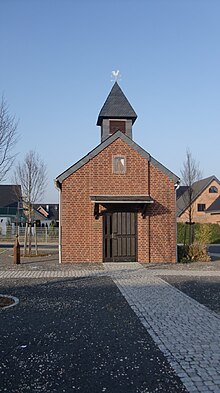New wood
|
(New) wood
City of Juchen
Coordinates: 51 ° 6 ′ 24 ″ N , 6 ° 27 ′ 11 ″ E
|
||
|---|---|---|
| Height : | approx. 90 m | |
| Residents : | 678 (Dec. 31, 2013) | |
| Postal code : | 41363 | |
| Area code : | 02164 | |
|
Location of (new) wood in North Rhine-Westphalia |
||
|
Location of (new) wood in the Rhenish lignite district
|
||
Holz (during the resettlement: Neu-Holz ) is a district of the city of Jüchen in the Rhein-Kreis Neuss in North Rhine-Westphalia . The place is the resettlement site for the abandoned site of wood (during the resettlement: old wood ), which was relocated for open-cast brown coal mining.
geography
In the north, wood borders on Mönchengladbach-Odenkirchen, in the east on Neu-Otzenrath and Neu-Spenrath , in the west on Wanlo and Wickrathberg and in the south on Hochneukirch .

history
Origin of the village name
The old village was first named after a farm whose owner was called Wynannt, with Winnadtsholz or Weinnandtsholz. Over time, the place name has been limited to the place name wood.
During the resettlement, the additional designation "New" or "Old" was added to the place name to differentiate between the old and new location. After the completion of the resettlement and demolition of the old location, the additional designation "New" was removed.
Settlement history
It has been known since the late 1960s that there was a Roman rubble site at the relocation site for (new) wood . In 1994, excavations and archaeological investigations began to isolate the rubble. The excavations took place from 1997 to 2000 because it was not possible to preserve the settlement. At the resettlement site, 700 years of uninterrupted settlement history have been documented; the oldest settlement dates back to the Late Hallstatt Period and the Late Latène Period around 450 BC. The courtyards here were from the 4th to 1st century BC. In addition to homesteads, numerous Celtic vessels were also found. A farm from the Elbe area from the 1st century AD was found northwest of the settlement from the Late Iron Age. A rectangular courtyard, the predecessor of the Roman Villa Rustica , was found 110 meters from it. In the 2/3. In the 19th century it was destroyed by fire and not rebuilt here. A post structure was found from the 4th century, which indicates an agricultural and craft settlement. Since 1999, the construction of new wood has started at the resettlement site.
Loreta Chapel
In the course of the resettlement, the old wood chapel was demolished. The diocese of Aachen announced three years ago that it would not have a new chapel built at the resettlement site. Church services should also no longer be celebrated. The chapel in the center of the village today was implemented by the interest group. The diocese of Aachen did not participate in the construction or the costs. The new chapel was inaugurated in 2007, a year later than originally planned. The design of the chapel came from the Aachen city planner Professor Horst Ulrich. The old chapel in old wood was to be taken as a model, other designs were rejected by the citizens' council. In addition to the furnishings of the old chapel, the chapel also houses the canopy, door and bells.
The war memorial from the old place found a new place next to the chapel.
population
| year | population |
|---|---|
| 2007 | 495 |
| 2010 | 598 |
| 2013 | 678 |
religion
The Catholic parish is in Hochneukirch , the Protestant one in Otzenrath .
traffic
Rail transport
The next train station is in Hochneukirch , it can be reached within 10 minutes on foot.
Bus transport
There are two bus stops in town, Jüchen Nordring and Jüchen Zur Kapelle. The buses run between Jüchen and Mönchengladbach. In Rheydt Hauptbahnhof and Mönchengladbach Hauptbahnhof you can change to local and long-distance traffic.
Street
The place is traffic-calmed. The next motorway entrance is on the A44 Mönchengladbach-Odenkirchen, the A 61 Mönchengladbach-Güdderath and the A46 near Jüchen .
literature
- N. Andrikopoulou-Stack, P. Enzenberger, K. Frank, CH Keller, N. Klän: An early Roman settlement in Jüchen-Neuholz. Considerations on settlement continuity in the Loessbörde. In: Bonner Jahrbücher. Volume 199, pp. 141-180.
- K. Frank, Ch. Keller: Jüchen-Neuholz. From the Iron Age homestead to the villa rustica. In: Gabriele Uelsberg: War and Peace. Celts - Romans - Teutons. Book accompanying the exhibition at the Rheinisches LandesMuseum Bonn, 2007, ISBN 978-3-89678-349-3 .
- Peter Staatz: Wood - The history of a village from the beginning to the relocation. (= History of the community of Jüchen. Volume 9). Klartext Verlag, Essen 2010, ISBN 978-3-8375-0370-8 .
- Christian Kandzorra: Wood - The move of a village in the lignite district of the Lower Rhine. The documentation of a resettlement in the Garzweiler II area. Hundt Druck, Cologne 2013, ISBN 978-3-00-040522-8 .
- Jürgen Kiltz: Hochneukirch, Holz, Otzenratz and Spenrath on postcards. (= History of the community of Jüchen. Volume 14). Hundt Druck, Cologne 2015, ISBN 978-3-00-049507-6 .
Web links
- Settlement history (summarized)
- Jüchen-Neuholz, from the Iron Age settlement to the Roman villa. ( Memento from January 5, 2013 in the web archive archive.today ) Settlement history (detailed)
- Inauguration of the chapel
- War memorial in wood
- Wayside cross wood
Individual evidence
- ↑ Population figures for the municipality of Jüchen ( Memento from July 22, 2010 in the Internet Archive )
- ↑ Population figures for the municipality of Jüchen ( Memento of the original from May 18, 2015 in the Internet Archive ) Info: The archive link was automatically inserted and not yet checked. Please check the original and archive link according to the instructions and then remove this notice. (Stand 2013)



